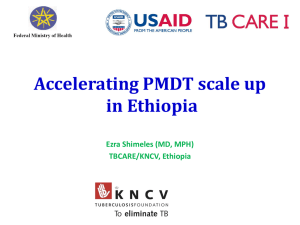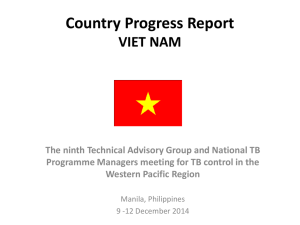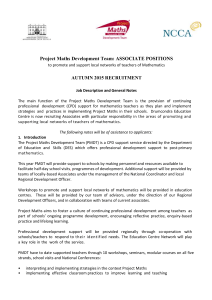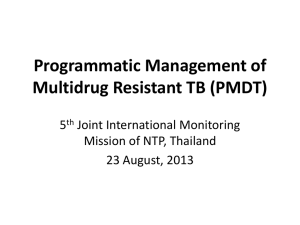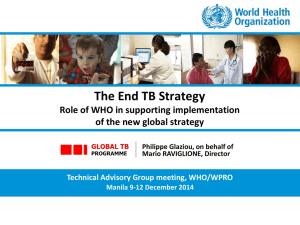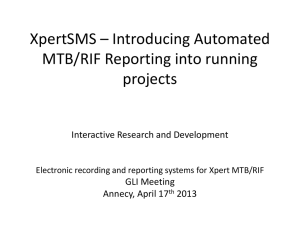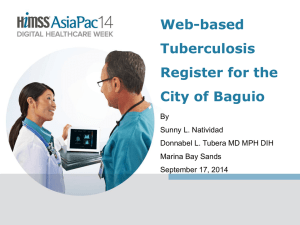Philippines - WHO Western Pacific Region
advertisement
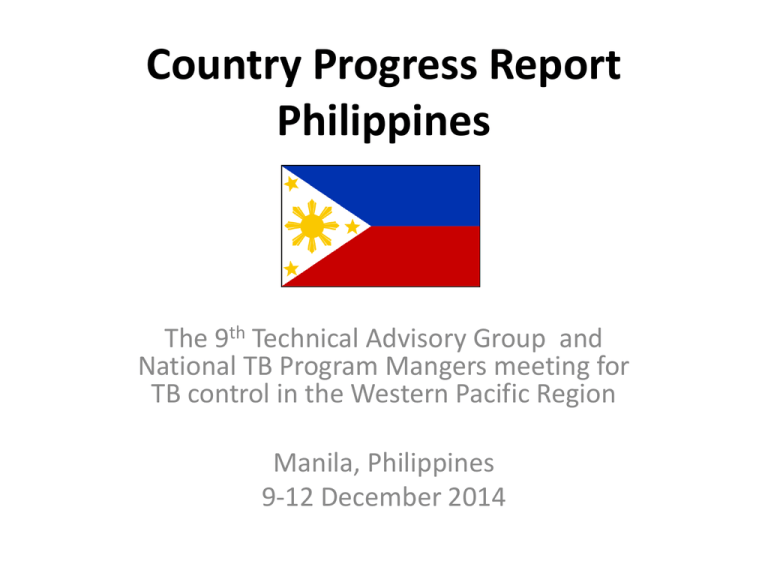
Country Progress Report Philippines The 9th Technical Advisory Group and National TB Program Mangers meeting for TB control in the Western Pacific Region Manila, Philippines 9-12 December 2014 Philippines • Archipelago of 7,100 islands • 100 million population, 17 regions • High TB burden and high MDR TB burden – 2012 DRS: 2% among new and 21% among retreatment cases • 1996 – start of DOTS strategy implementation and in 2003 with 100% DOTS coverage in the public sector, adoption of PPMD strategy as a national strategy • 1999 – Start of PMDT in the private sector and 2008 mainstreamed to NTP • 2013 – Mortality rate: 27/100,000 Prevalence:438/100,000 Incidence: 292/100,000 – Case Detection Rate: 87, Treatment Success Rate: 88 Major Successes • NTP policies and guidelines are updated to align with international policies and will be implemented nationwide in 2015 • TB services are provided for free and are integrated with basic health services nationwide • With 2010-2016 National TB Control Strategic plan that has been reviewed and updated • With multi-sectoral involvement – private sector and other government agencies • With scale-up of diagnostic and treatment services for drug resistant TB cases • With strong political commitment from the government (increasing budget for the TB program) • With financing package for TB (Philhealth package) Major Challenges • Still many missing TB cases due to; – Lack of access to quality assured TB diagnostic services and passive casefinding, TB is not a reportable disease – Limited involvement of non-NTP care providers – Persisting stigma on TB • Low number of detected and enrolled MDR-TB cases and with high number of default. • Weak TB HIV collaboration especially at the service delivery level and limited geographic coverage • Slow development and implementation of initiatives to increase access to TB services by vulnerable groups • Weak health system – Weak logistics and information management systems – Variable capacity in TB control program management by TB teams at all levels – Lack of manpower at the service delivery levels 2010-2016 Philippine Plan of Action to Control TB (PhilPACT) Objectives Reduce local variation in TB control program performance Scale up and sustain coverage of DOTS implementation Strategies 1. Localize implementation of TB control 2. Monitor health system performance 3. Engage both public and private health care providers 4. Promote and strengthen positive behaviour of the communities 5. Address MDR-TB, TB/HIV, and needs of vulnerable population Ensure provision of quality 6. Regulate and make available quality TB diagnostic tests and drugs TB services 7. Certify and accredit TB care providers 8. Secure adequate funding and improve Reduce out-of-pocket allocation and efficiency of fund utilization expenses related to TB care Outcome Targets based on PhilPACT Indicators Status as of Dec 2013 Susceptible patients Case Detection Rate, all 87% forms Treatment Success Rate, all 88% forms MDR-TB patients Notification Rate 16% Treatment Success Rate 41% 2016 Targets 90% 90% 62% 75% Output Targets based on PhilPACT Indicator Total no. of presumptive TB examined Total TB cases provided with treatment Total no. of children given treatment or given INH preventive therapy Total MDR-TB cases detected and registered Total TB patients who underwent provider initiated counselling and testing on HIV/AIDS Status as of Dec 2013 2016 Targets 2,481,418 (45%) 5.5 million 855,904 (57%) 1.5 million 102,747 (14%) 730,000 7,883 (40%) 19,500 8,623 (19%) 45,000 Funding for PhilPACT Per Year 2010 - 2016 18,000 16,000 14,000 12,000 10,000 8,000 6,000 4,000 2,000 0 2010 2011 2012 2013 2014 2015 2016 TOTAL 750 756 792 1,465 2,689 2,598 2,971 TOTAL (20142016) 8,258 OOP 587 567 568 588 661 543 558 1,762 PHIC 0 0 0 0 0 0 0 0 FAPS 0 0 0 160 1,099 639 943 2,681 LGU 163 189 224 717 824 878 908 2,609 NG 0 0 0 0 105 538 562 1,205 Reach the Unreached • Policy on intensified casefinding among close contacts, high-risk clinical groups (PLHIV, DM, etc), high risk populations (inmates, elderly, urban and rural poor) • Screening of presumptive TB using DSSM, GenExpert and Chest X-ray for bacteriologically confirmed and clinically diagnosed cases • Hiring of additional staff (AIDERS), deployed to hard to reach and poor areas • With TB HIV collaboration – HIV counseling and testing for registered TB cases in category A and B areas and all PMDT treatment facilities. PLHIV screened for TB in HIV treatment hubs. • Engagement of public (35%) and private hospitals (18%) • 54% of inmates with access to DOTS services • Engagement of pharmacies for referring patients • With final draft policy for TB during disaster (for signature) Laboratory Strengthening • Improvement of access to diagnostic services through – Introduction of LED FM in 60 intermediate and peripheral laboratories – Expansion of GenExpert sites (73), culture (20) and DST centers (3) – Involvement of the private sector • Ensuring quality services through EQA for microscopy, monitoring of workload, Turn-Around-Time and error rates for GenExpert sites, monitoring of culture and DST laboratory performance indicator and annual proficiency testing for DST laboratories • Technical assistance for system strengthening of – Laboratory information system linked to ITIS – Quality assurance – Policy formulation (use of rapid tests and diagnostic algorithm) – Monitoring and evaluation Surveillance • New case definitions are already used by all PMDT facilities and in 2015 by all DOTS facilities nationwide • With Integrated TB information system (in 6/17 regions). For enhancement to include Modules for laboratory, inventory and pharmacovigilance (routine and CEM) • Data are analyzed during monitoring, program implementation reviews and program evaluation Expansion of PMDT Diagnostic and Treatment Facilities CAR (1) 2003 2007 2008 2009 2011 2012 2013 2014 NCR Region 7 Region 1 CAR Region 4B Region 2 ARMM Region 4A Region 6 Region 3 Region 5 Region 9 Region 8 Region 10 Region 12 Region 11 CARAGA RO 1 (2) (1) Regional Expansion RO 2 (1) RO 3 (1) RO4A 4A(6) (5) (1) (2) RO NCR(12) (5) NCR NCR (14) (16) RO 5 (2) (1) (3) RO 6 (5) (2) RO 4B (1) RO 8 (1) (3) RO 7 (2) (1) CARAGA (1) New No. of Facilities RO 10 (2) (1) RO 9 (2) (1) ARMM (1) No. of Gx Labs RO (1) RO 12 12 (2) (3) RO 11 (2) (1) Cumulative No. of Facilities 5 16 17 24 73 1 5 15 12 6 10 6 11 26 38 44 54 Trend of Enrollment and Treatment Outcome of Patients under PMDT Enrollment Treatment Outcome PMDT Targets and Activities Diagnostic Facilities: • 199 GeneXpert sites • 180 thru GF • 19 from other sources • 28 culture laboratories • 7 DST Centers Treatment Facilities: • TC: 20 • STC: 110 • iDOTS facilities Other Initiatives • 9 month Treatment Regimen • Use of Bedaquiline • e-TAP • Community PMDT Care • Enhancement of Information System • Enhancement of Logistics System Enrollment: 2015: 4365 2016: 5177 Treatment Success Rate: 75% Decentralize Quickly Bold Policies and Supportive Systems • With existing PhilHealth package for Drug Susceptible TB (90U$ per TB case) • Expansion to include a package for Drug Resistant TB – situational analysis for dissemination; actuarial study in 2015; policy in 2016 • TB case notification to coordinate with other DOH offices and to include in the pending bill on TB control • Meeting with FDA and other stakeholders – Pharmaco-vigilance system enhancement – Limit commercial access of anti-TB drugs Patient Centered care: involvement of patients and Community • Patient groups are involved in NTP activities on advocacy, planning and evaluation and as treatment partner • Plan – Capacitate patients as counselors or peer educators – Provide funds for patient activities and link patient group to other government agencies for livelihood opportunities – Provide enablers through the enhance transportation allowance package (e-TAP) as well as food package – Hire staff (AIDERS) to assist in detecting and following-up of TB cases • Involvement of NGOs, Community Health Teams, community groups for referral of cases, providers of services and to follow-up cases Thank you!
